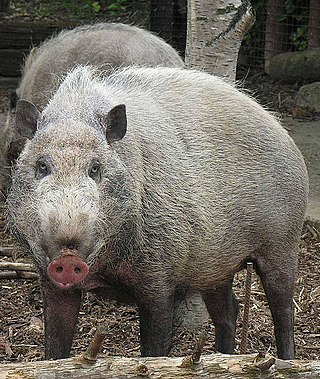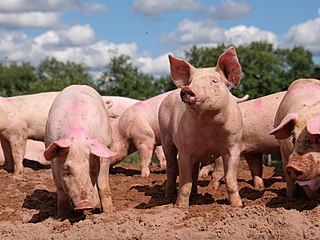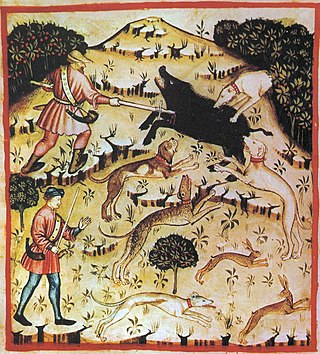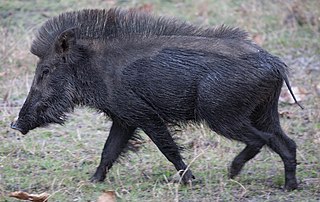
Sus is the genus of wild and domestic pigs, within the even-toed ungulate family Suidae. Sus include domestic pigs and their ancestor, the common Eurasian wild boar, along with other species. Sus species, like all suids, are native to the Eurasian and African continents, ranging from Europe to the Pacific islands. Suids other than the pig are the babirusa of Indonesia, the pygmy hog of South Asia, the warthogs of Africa, and other pig genera from Africa. The suids are a sister clade to peccaries.

The wild boar, also known as the wild swine, common wild pig, Eurasian wild pig, or simply wild pig, is a suid native to much of Eurasia and North Africa, and has been introduced to the Americas and Oceania. The species is now one of the widest-ranging mammals in the world, as well as the most widespread suiform. It has been assessed as least concern on the IUCN Red List due to its wide range, high numbers, and adaptability to a diversity of habitats. It has become an invasive species in part of its introduced range. Wild boars probably originated in Southeast Asia during the Early Pleistocene and outcompeted other suid species as they spread throughout the Old World.

Suidae is a family of artiodactyl mammals which are commonly called pigs, hogs or swine. In addition to numerous fossil species, 18 extant species are currently recognized, classified into between four and eight genera. Within this family, the genus Sus includes the domestic pig, Sus scrofa domesticus or Sus domesticus, and many species of wild pig from Europe to the Pacific. Other genera include babirusas and warthogs. All suids, or swine, are native to the Old World, ranging from Asia to Europe and Africa.

Trichinella is the genus of parasitic roundworms of the phylum Nematoda that cause trichinosis. Members of this genus are often called trichinella or trichina worms. A characteristic of Nematoda is the one-way digestive tract, with a pseudocoelom.

The pig, often called swine, hog, or domesticpig when distinguishing from other members of the genus Sus, is an omnivorous, domesticated, even-toed, hoofed mammal. It is variously considered a subspecies of Sus scrofa or a distinct species. The pig's head-plus-body length ranges from 0.9 to 1.8 m, and adult pigs typically weigh between 50 and 350 kg, with well-fed individuals even exceeding this range. The size and weight of hogs largely depends on their breed. Compared to other artiodactyls, a pig's head is relatively long and pointed. Most even-toed ungulates are herbivorous, but pigs are omnivores, like their wild relative. Pigs grunt and make snorting sounds.
Aujeszky's disease, usually called pseudorabies in the United States, is a viral disease in swine that is endemic in most parts of the world. It is caused by Suid herpesvirus 1 (SuHV-1). Aujeszky's disease is considered to be the most economically important viral disease of swine in areas where classical swine fever has been eradicated. Other mammals, such as cattle, sheep, goats, cats, dogs, and raccoons, are also susceptible. The disease is usually fatal in these animal species.

Moccus is a Celtic god who is identified with Mercury. He is the boar- or swine-god of the continental Celtic tribe of Lingones. Moccus was invoked as the protector of boar hunters and warriors. Boar meat was sacred among the ancient Celts, and features in accounts of feasts in Irish mythology. The Lingones, whose tribal center was at modern-day Langres, were a Gaulish tribe located in the area of the rivers Seine and Marne in what is now northeastern France. They were neighbors to the Celto-Germanic tribe of Treveri. Another tribe known as Lingones was located near the mouth of the Po River in northeastern Italy, and were known for agriculture, weaving and metalworking.
Swine most commonly refers to the domestic pig.

Boar hunting is the practice of hunting wild boar, feral pigs, warthogs, and peccaries. Boar hunting was historically a dangerous exercise due to the tusked animal's ambush tactics as well as its thick hide and dense bones rendering them difficult to kill with premodern weapons.

Boar–pig hybrid is a hybridized offspring of a cross between the Eurasian wild boar and any domestic pig. Feral hybrids exist throughout Eurasia, the Americas, Australia, and in other places where European settlers imported wild boars to use as game animals. In many areas, a variable mixture of these hybrids and feral pigs of all-domesticated original stock have become invasive species. Their status as pest animals has reached crisis proportions in Australia, parts of Brazil, and parts of the United States, and the animals are often freely hunted in hopes of eradicating them or at least reducing them to a controllable population.
A pig is a mammal of the genus Sus.

The Palawan bearded pig is a pig species in the genus Sus endemic to the Philippines, where it occurs on the archipelago of islands formed by Balabac, Palawan, and the Calamian Islands. It is 1 to 1.6 m in length, about 1 m (3.3 ft) tall and weigh up to 150 kg (330 lb).

The banded pig also known as the Indonesian wild boar is a subspecies of wild boar native to the Thai-Malay Peninsula and many Indonesian islands, including Sumatra, Java, and the Lesser Sundas as far east as Komodo. It is known as the wild boar in Singapore. It is the most basal subspecies, having the smallest relative brain size, more primitive dentition, and unspecialised cranial structure. It is a short-faced subspecies with a white band on the muzzle, as well as sparse body hair, no underwool, a fairly long mane, and a broad reddish band extending from the muzzle to the sides of the neck. It is much smaller than the mainland S. s. cristatus subspecies, with the largest specimens on Komodo weighing only 48 kg.

The Indian boar, also known as the Andamanese pig or Moupin pig, is a subspecies of wild boar native to India, Nepal, Myanmar, western Thailand, Bangladesh and Sri Lanka

The Japanese boar, also known as the white-moustached pig, nihon-inoshishi (ニホンイノシシ), or yama kujira, is a subspecies of wild boar native to all of Japan, apart for Hokkaido and the Ryukyu Islands.

The Central Asian boar is a small long maned subspecies of wild boar indigenous to Southeastern Iran, Pakistan and Northwest India.

The Barbary wild boar is a smaller subspecies of wild boar native to North Africa including Morocco, Algeria and Tunisia. It is a prey animal for past and present predators of the Atlas Mountains, such as striped hyenas, Atlas bears, African leopards and Barbary lions.

Germanic boar helmets are attested in archaeological finds from England and Sweden, dating to Vendel and Anglo-Saxon periods, and Old English and Old Norse written sources. They consist of helmets decorated with either a boar crest or other boar imagery that was believed to offer protection in battle to the wearer. They have also been proposed to be a costume for the ritual transformation into a boar, similar to berserkers, and to be associated with Freyr.














